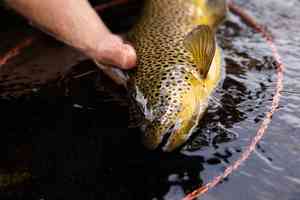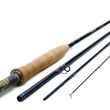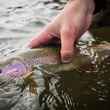In the Finger Lakes region of upstate New York, from mid October to early December, landlocked Atlantic salmon run up countless tributaries to spawn, often coming in waves as water levels rise and fall with autumn rains. I have been fly fishing for them since I was barely out of diapers. Over the years, I have honed the gear and techniques I employ in search of these leaping salmonids, but I am always experimenting and refining.
As time has passed, I've found myself gravitating steadily towards water-loaded and single hand spey-style casts with my trusty 10' 7wt and so, naturally, I have flirted with the idea of picking up a switch rod. For one reason or another, I never pulled the trigger. I was happy enough with what I had, and money was prioritized in different directions. But then the ECHO OHS came onto my radar—a purported missing link between single hand and spey rods—and I had to check it out for myself.
Beyond occasionally borrowing a friend's, playing around with the Echo OHS was my deepest foray into the world of spey style rods and interchangeable head systems. But don't let the mention of spey casting fool you, the OHS isn't a two-hander. OHS stands for One Hand Spey.
The ECHO OHS is intended to be used for single-handed spey style casting which incorporates a haul to shoot the line at the end of the casting stroke. But what's cool about the OHS is that it allows you to overhand cast as well. Matched with a Skagit style shooting head, you get to enjoy the benefits of a switch rod without sacrificing the ability to pick up and cast when needed. The casts I was doing with my standard fly rod and line setup were very similar to the casts the OHS was designed for, so it seemed like the perfect choice. The OHS is available in 6-8wts, and all models measure 10' 4." I went with the 7wt, and borrowed some lines from friends to explore different weight and head styles before committing. ECHO recommends between 240-270 grain heads, but I read about some people going much higher. I split the difference with a 300 grain head, which quickly became my favorite of the weights I tried. Then I put together some homemade floating and sinking tips and hit the tributaries.
What works
Value
I have owned and fished quite a few ECHO rods over the years, and the OHS is no exception to the quality and value one would expect. The four piece pearl green blank features chrome snake guides and silicon carbide (SIC) stripping guides, an anodized aluminum reel seat, and a full Wells style cork grip. The OHS comes in a fabric-covered hard rod case and cloth sock, and includes both a threaded single hand and spey style fighting butt. She'll run you about $475 new, which is one of ECHO's pricier offerings—but you get what you pay for, and he OHS looks and feels like a quality stick worth the price tag.
Warranty
Having required their services myself in the past, I can say from personal experience that the ECHO Lifetime Warranty and customer service are also excellent. They'll fix or replace almost anything for about $35 plus shipping, and get it back to you quickly.
Casting stroke
I read several reviews that warned that this rod is not ideal for true two hand spey/switch style casts, and I have found that to be somewhat true. Though I could pull them off, I much prefer the single hand water-loaded-haul-casts (for lack of a better description) that characterize the OHS. As such— assuming you've found a good line pairing—your enjoyment of this rod will depend on your ability to make effective use of hauling. It's all about well timed hauls to load the rod and send your cast into the next area code. Just get your line in position, load your rod off the water to form your D-loop, give it a haul on your forward stroke and let it rip. It's pretty amazing how far you can shoot this thing for how relatively effortless it is to cast, and the compact casting stroke is really nice on small, packed rivers with minimal room to set anchors and pull off more elaborate spey casts.

Flow
The OHS is special because of what it enables you to do, combining overhand and spey casting into something unique, for a rhythm that is enjoyable to perform and thorough in its coverage. There aren't many rods out there that allow you to pick up and accurately cast to a run right in front of you and then send an 80 foot roll cast to another in quick succession.There's a real flow to this rod, and transitioning between actively fishing, anchoring, and casting is super smooth. With the mixture of a short (by spey standards) high modulus rod and Skagit head, the stages of your casting stroke reach apex quickly, and you can use your hauls to expedite the transfer of energy at each point. The OHS also executes continuous motion casts, like the snake roll, very well.
Overhand casting
Despite the 300 grain shooting head that I prefered, I had no problem casting overhand when needed. Even with the heavy head and a sink tip, picking up and overhand casting is very comfortable, and you don't get that overlined feeling you might expect. You're not going to get the most gentle presentation, but this ain't your dry fly rig. There were multiple occasions this October while fishing for Atlantics that I needed to quickly pick up and cast to a breaching fish, and the OHS made it easy. I also tried the OHS with a few traditional fly lines of various weights and tapers just to play around, and while you sacrifice a lot of the rod's ability to pull off spey/switch casts, you can absolutely fish the rod overhand or with very respectable roll casts.
Versatility
From actively stripping streamers, to more traditional swinging, to dead drifting, to floating indicators, and even tightlining, the OHS gives you a lot of options. The rod length makes it great for nymphing, long mends, etc., and the action is great for picking up heavy flies and sink tips from below the surface. While the OHS is ultimately a salmon/steelhead river rod, I could see it being useful for a variety of fishing applications. I think it would be worth trying out for lake fishing, on smallmouth water, or possibly even for modest surf fishing. The quick load and haul casting style with a heavy skagit head would lend itself well to the beach, and allow you to cast farther with less energy than trying to false cast and aerialize a ton of line while being pummeled by waves.
What doesn't
Learning curve
The OHS might be a bit much for a brand new fly caster to figure out, but with the right line pairing, any decent one hand caster who understand water loading should be able to cast reasonably well within a day of picking it up. An average two-hand caster shouldn't have any problem learning the OHS provided they can correctly incorporate the hauls.The hardest part for me was finding the optimal head and tip combination, but once I did, it was game on.
Final word
I don't think calling the OHS both versatile and specialized is an oxymoron. There are certain types of fisherman that the OHS will appeal to, and I think they will be very happy with it. A serious salmon or steelhead angler, whether they use a one-hand rod and are thinking about a switch setup, or a dedicated two-hand angler looking to mix things up and get a bit more versatility out of their gear would be wise to give the OHS some consideration. The OHS being somewhat specialized, and not necessarily cheap, you'll have to decide if it's worth the investment for yourself. With the OHS, you'll also need to factor in the added cost of different heads, running line, and tips. I think my next purchase will be an integrated line (where the shooting head and running line are part of the same continuous line) just to keep the whole system simple and seamless. As far as I'm concerned, the less loop to loop connections running through the guides, the better.
I hoped the ECHO OHS would be the perfect small tributary Atlantic salmon rod, and it did not disappoint. It's a slick casting rod that blurs the lines between one and two-handed setups, and accomplishes its intended use extremely well. When equipped with a short Skagit-style head and incorporating single and double hauls into your water loaded casting stroke, you can really take advantage of the OHS's design and shoot a lot of line with minimal effort. The OHS shines in tight quarters where you still need to reach out to the other side of the river. What's more, is that despite the heavy heads and tips you'll likely be using, it is a respectable overhand caster as well. The OHS opens some doors that a dedicated one or two-hand rod can't quite fit through, enabling the angler to do pretty much anything you'd want to do with either, and some things you can't. Fishing the OHS is an experience that reimagines and refines familiar casts into something new and unique.






























Comments